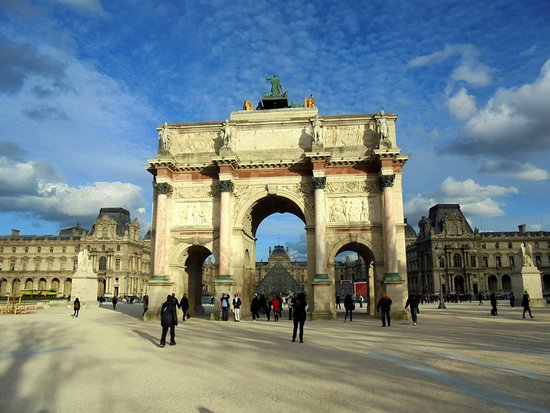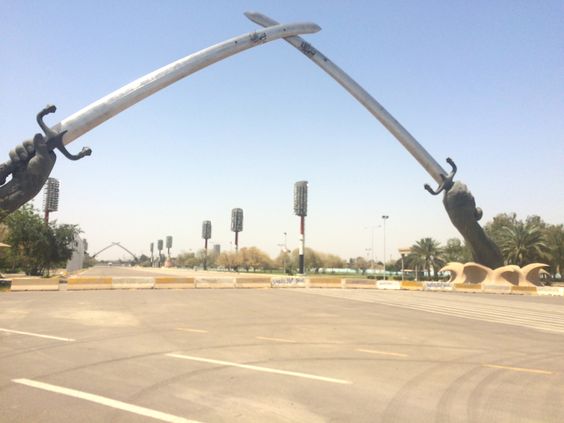While The Arc de Triomphe de l’Etoile in Paris has come to be considered by many as THE Arch of Triumph- the original Triumphal Arch Geeks were, of course, the ancient Romans. They built them everywhere they could find an excuse to and fortunately we still have amazing imperial period examples of their work standing throughout Europe and Africa, such as the Arch of Titus in Rome or the Arch of Hadrian in Jerash.
Here however we’re going to take a look at some of the more interesting or lesser-known Modern Victory Arches around the world. From Paris’s oft-forgotten cousin to the curiously familiar Arch of Triumph in Pyongyang.
Table of Contents
- Arc de Triomphe du Carrousel- Paris, France
- Arc de Triomphe de Carabobo- Carabobo, Venezuela
- Patuxai – Vientiane, Laos
- The Victory Arch AKA Swords of Qadisiyah- Baghdad, Iraq
- The Arch of Triumph- Pyongyang North Korea
5. Arc de Triomphe du Carrousel- Paris, France
Doomed to forever be overshadowed by it’s more famous brother The Arc de Triomphe de l’Etoile, Inspired by the Arch of Constantine in Rome it was completed between 1806 and 1808 so it did at least get to be the Arch of Triumph in Paris for 28 years while it’s bigger brother was still under construction.
Standing 63 feet (19 meters) high and 75 feet (23 meters wide), it was originally topped by the Horses of Saint Mark which Napoleon had nicked from Saint Mark’s Cathedral, Venice in 1798. Thankfully for the Cathedral, The Battle of Waterloo kicked off a few things around Europe at the time, and the Cathedral got it’s horsies back. The French, therefore, had to design their own arch topper, picking a design that featured Peace being drawn by a quadriga with gilded victories on either side.
4. Arc de Triomphe de Carabobo- Carabobo, Venezuela
Built-in 1921 to commemorate the 100th anniversary of the victory by Simon Bolivar and the Gran Colombian Forces over the Realist army that supported the Spanish Crown. While the battle of Carabobo was not the end of the war for independence it essentially destroyed the Realists as a force in the North and is thus considered the battle that won the war. The arch is formed by two 28 meter columns that meet with an arch in the center.
3. Patuxai – Vientiane, Laos
Built between 1957 and 1968, Patuxai means Victory Gate or Gate of Triumph. It is sometimes also known as the Arch of Triumph in Vientiane due to it’s superficial resemblance to the Parisian Arch of Triumph. However the design clearly includes many Laotian elements and considering it is dedicated to those who died firstly in World War 2 and then in the fight for independence from France, it’s probably best to stick with Patuxai, if you’re asking for directions.
The monument was originally merely known as “the monument” (Anousavary) and was built using cement and funds given to the Royal government by the United States to build an airport. The name Patuxai was given in 1975 when Pathet Lao overthrew the government and ended the Monarchy. He then installed a communist regime with the help of the North Vietnamese Army.
2. The Victory Arch AKA Swords of Qadisiyah- Baghdad, Iraq
Unlike our other arches, this one is actually 2 with one set marking each entrance to the Grand Festivities square and the Iran-Iraq war Commemorative Parade ground. Each Arch stands 40 meters high (130ft) and is constructed out of concrete, stone, stainless steel and bronze. The Arches were opened in 1989 after three years of construction. It is dedicated to Fallen Iraqi soldiers.
The blades of the swords consist of 24 tonnes of stainless steel and were cast in Iraq partially using guns from fallen soldiers and tanks that had been destroyed in the Iran-Iraq war. Other elements of the statue such as the arms and hands holding the swords were cast abroad as Iraq lacked a foundry capable of dealing with a monument of this size. (These were cast in the U.K).
The Arches were partially destroyed in 2007 after a decision by the Committee for Removing Symbols of the Saddam Era- however, intervention by the American Ambassador led to a reversal of this decision. Restoration of the damage already done took place in February 2011.
1. The Arch of Triumph- Pyongyang North Korea
Known in Korean as Kaesonmun, this Arch was built in 1982 to honour the 70th Birthday of the President Kim Il Sung. The arch is the second highest in the world, after the Monument to the Revolution in Mexico, but what makes this one so special is the extreme resemblance it has to the Arch of Triumph in Paris, the main difference between them being this one is 10 meters higher.
Inside the monument are lifts and several rooms, including one for watching videos about the monument and selling souvenirs. The Arch is marked with the dates 1925 and 1945 representing the year that Kim Il Sung is said to have begun his Anti-Japanese activities and the year of liberation from Japanese rule.










